Another significant feature of the recent OneFS 9.4 release is support for quad-level cell (QLC) flash media. Specifically, the PowerScale F900 and F600 all-flash NVMe platforms are now available with 15.4TB and 30.7TB QLC NVMe drives.
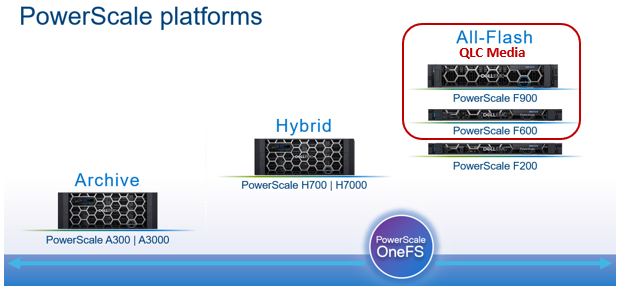
These new QLC drives offer the gamut of capacity, performance, reliability and affordability – and will be particularly beneficial for workloads such as artificial intelligence, machine and deep learning, and for media and entertainment environments.
The details of the new QLC drive options for the F600 and F900 platforms are as follows:
| PowerScale Node | Chassis specs
(per node) |
Raw capacity
(per node) |
Max Raw capacity (252 node cluster) |
| F900 | 2U with 24 NVMe SSD drives | 737.28TB with 30.72TB QLC
368.6TB with 15.36TB QLC |
185.79PB with 30.72TB QLC
92.83PB with 15.36TB QLC |
| F600 | 1U with 8 NVMe SSD drives | 245.76TB with 30.72TB QLC
122.88TB with 15.36TB QLC |
61.93PB with 30.72TB QLC
30.96PB with 15.36TB QLC |
This means an F900 cluster with the 30.7TB QLC drives can now scale up to a whopping 185.79PB in size, with a nice linear performance ramp!
So the new QLC drives double the all-flash capacity footprint, as compared to previous generations – while delivering robust environmental efficiencies in consolidated rack space, power and cooling. What’s more, PowerScale F600 and F900 nodes containing QLC drives can deliver the same level of performance as TLC drives, thereby delivering vastly superior economics and value. As illustrated below, QLC nodes performed at parity or slightly better than TLC nodes for throughput benchmarks and SPEC workloads.
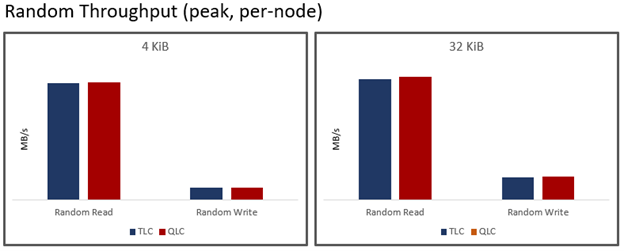
The above graphs show the comparative peak random throughput per-node for both QLC and TLC.
QLC-based F600 and F900 nodes can easily be rapidly and non-disruptively integrated into existing PowerScale clusters, allowing seamless data lake expansion and accommodation of new workloads.
Compatibility-wise, there are a couple of key points to be aware of. If attempting to add a QLC drive to a non-QLC node, or vice versa, the unsupported drive will be blocked with the ‘WRONG_TYPE’ error. However, QLC and non-QLC nodes will happily coexist in different pools within the same cluster. But attempting to merge storage node pools with differing media classes will output the error ‘All nodes in the nodepool must have compatible [HDD|SSD] drive technology’.
From the WebUI, the ‘drive details’ pop-up window displays ‘NVME, SSD, QLC’ as the ‘Connection and media type’. This can be viewed by navigating to Hardware configuration > Drives and selecting ‘View details’ for the desired drive:
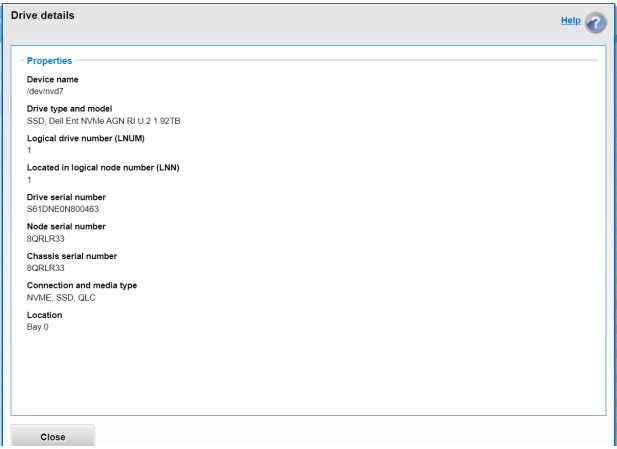
The WebUI SmartPools summary, available by browsing to Storage pools > SmartPools, also incorporates ‘QLC’ into the pool name:
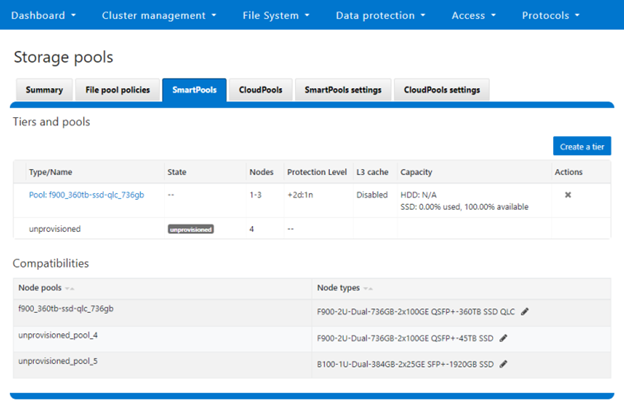
Similarly, in the ‘node pool details’:
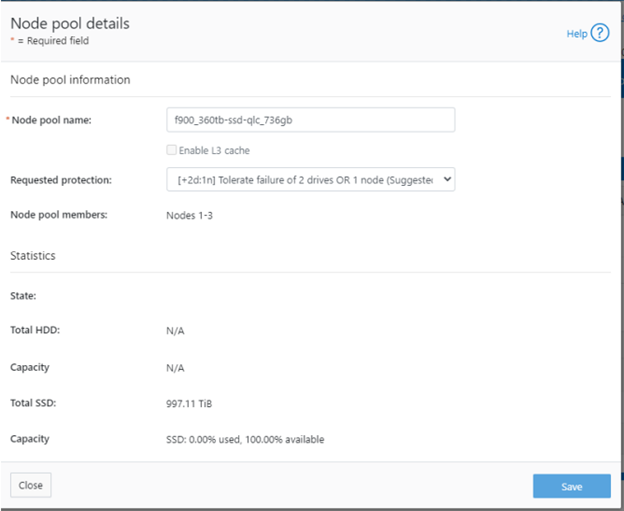
From the OneFS CLI, existing commands displaying DSP (drive support package), PSI (platform support infrastructure), and storage and node pools display a new ‘media_class’ string, ‘QLC’. For example:
# isi storagepool nodepools ls ID Name Nodes Node Type IDs Protection Policy Manual ------------------------------------------------------------------------- 1 f600_15tb-ssd-qlc_736gb 1 1 +2d:1n No 2 3 ------------------------------------------------------------------------- Total: 1
# isi storagepool nodetypes ls ID Product Name Nodes Manual -------------------------------------------------------------- 1 F600-1U-Dual-736GB-2x25GE SFP+-15TB SSD QLC 1 No 2 3 -------------------------------------------------------------- Total: 1
OneFS 9.4 also introduces new model and vendor class fields, providing a dynamic and extensible path to determine what drive statistics and information to gather, how to capture them, and how to display them – in preparation for future drive technologies. For example:
# isi_radish -a Bay 0/nvd15 is Dell Ent NVMe P5316 RI U.2 30.72TB FW:0.0.8 SN:BTAC1436043630PGGN, 60001615872 blks Log Sense data (Bay 0/nvd15 ) – Supported log pages 0x1 0x2 0x3 0x4 0x5 0x6 0x80 0x81 SMART/Health Information Log ============================ Critical Warning State: 0x00 Available spare: 0 Temperature: 0 Device reliability: 0 Read only: 0 Volatile memory backup: 0 Temperature: 297 K, 23.85 C, 74.93 F Available spare: 100 Available spare threshold: 10 Percentage used: 0 Data units (512,000 byte) read: 1619199 Data units written: 10075777 Host read commands: 67060074 Host write commands: 4461942671 Controller busy time (minutes): 1 Power cycles: 21 Power on hours: 420 Unsafe shutdowns: 18 Media errors: 0 No. error info log entries: 0 Warning Temp Composite Time: 0 Error Temp Composite Time: 0 Temperature 1 Transition Count: 0 Temperature 2 Transition Count: 0 Total Time For Temperature 1: 0 Total Time For Temperature 2: 0
Finally, PowerScale F600 and F900 nodes must be running OneFS 9.4 and the latest DSP in order to support QLC drives. In the event of a QLC drive failure, it must be replaced with another QLC drive. Additionally, any attempts to downgrade a QLC node to a version prior to OneFS 9.4 will be blocked.